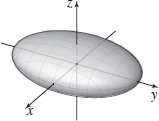REVIEW EXERCISESPrinted Page 9999
Opposite vertices of a rectangular box whose edges are parallel to the coordinate axes are (1, 0, 2) and (2, 3, 4). List the coordinates of the other six vertices of the box.
(1,0,4), (2,3,2), (2,0,2), (2,0,4), (1,3,4), (1,3,2)
Describe in words the set of all points (x,y,z) that satisfy y=3.
The vector v has initial point P1=(5,0,−2) and terminal point P2=(7,1,3).
- (a) Write the vector v in terms of its components.
- (b) Write the vector v in terms of standard basis vectors.
- (a) v=⟨2,1,5⟩
- (b) v=2i+j+5k
Find the magnitude of the vector v= i+2j+3k.
Find the distance between the points (1,2,3) and (7,5,1).
7
Write the equation of the sphere with center at the point (1,2,3) and radius 4.
Find the radius and center of the sphere: x2+y2+z2−4x+8y=5.
Center (2,−4,0); radius 5
If v=⟨−2,−1,3⟩ and w=⟨5,4,−2⟩, find 3v−2w.
If v=2i+3j−k and w=−i−2j+3k, find ‖.
\sqrt{6}
Find a unit vector in the direction of \mathbf{v}=4\mathbf{i} +12\mathbf{j}-3\mathbf{k}.
Find a vector \mathbf{v} in the plane with magnitude 25 if the angle between \mathbf{v} and \mathbf{i} is 120^\circ.
-\dfrac{25}2\mathbf{i}+\dfrac{25\sqrt{3}}2\mathbf{j}
Find \mathbf{v} and \mathbf{w} if \mathbf{w}-3\mathbf{v}=2\mathbf{i}+\mathbf{j}-\mathbf{k}\qquad\hbox{and}\qquad 2\mathbf{w}+\mathbf{v}=\mathbf{i}+\mathbf{j}
- (a) Find the magnitude and direction cosines of the vector \mathbf{v}=5\mathbf{i}+8\mathbf{j}-2\mathbf{k}.
- (b) Write \mathbf{v} in terms of its magnitude and direction cosines.
- (a) || \mathbf{v}||=\sqrt{93}; \cos\alpha=\dfrac{5}{\sqrt{93}}, \cos\beta=\dfrac{8}{\sqrt{93}}, \cos\gamma=-\dfrac2{\sqrt{93}}
- (b) \mathbf{v}=\sqrt{93}\left(\dfrac{5}{\sqrt{93}}\mathbf{i}+\dfrac{8}{\sqrt{93}}\mathbf{j}-\dfrac2{\sqrt{93}}\mathbf{k}\right)
Find the vector projection of \mathbf{v}=3\mathbf{i}+\mathbf{j} -2\mathbf{k} on \mathbf{w}=5\mathbf{i}-\mathbf{j}+\mathbf{k}. Decompose \mathbf{v} into two vectors \mathbf{v}_{1} and \mathbf{v}_{2}, where \mathbf{v}_{1} is parallel to \mathbf{w} and \mathbf{v}_{2} is orthogonal to \mathbf{w}.
Find the work done in moving an object along a vector \mathbf{u }=3\,\mathbf{i}+2\,\mathbf{j}-5\mathbf{k} if the applied force is \mathbf{F }=2\mathbf{i}-\,\mathbf{j}-\mathbf{k} . Use meters for distance and newtons for force.
9 J
Three forces are applied to an object in mutually orthogonal directions: 12 units along the x-axis, 16 units along the y-axis, and 15 units along the z-axis. What is the resultant force?
Find the angle between the vectors \mathbf{u}=\mathbf{i}+2 \mathbf{j}+3\mathbf{k} and \mathbf{v}=2\mathbf{i}-3\mathbf{j}-\mathbf{k}.
\cos^{-1}\left(-\dfrac12\right) = \dfrac{2\pi}{3} radians
Find the angle at the vertex A of the triangle ABC with vertices A=(1, 0, 1), B=(2, -1, 1), and C=(-2, 1, 0).
Find the distance between the parallel planes \begin{array}{l@{\quad}rcl} p_{1} :& x+y-z&=&1 \\ p_{2} :& -2x-2y+2z&=&2 \end{array}
\dfrac2{\sqrt{3}}
A rigid body rotates with constant angular speed of \omega radians per second about a line through the origin and parallel to 2\mathbf{ i}+3\mathbf{j}+6\mathbf{k}. Find the speed of an object on this body at the instant it passes through the point (1, 2, 3). Assume the distance is in meters.
Find the line perpendicular to the lines \begin{array}{lrcl@{\qquad}rcl@{\qquad}rcl} l: & \quad x&=&1-t, \quad & y&=&t, \quad & z&=&2t-1 \\ m: & \quad x&=&t+1, & y&=&-t, & z&=&t-1 \end{array}
x=1+3t, y=3t, z=-1
Find the line containing the point (1, 2, 3) in the direction of \mathbf{v}=2\mathbf{i}-\mathbf{j}-4\mathbf{k}.
Find the scalar a so that \mathbf{v}=2\mathbf{i}-\mathbf{j} -4\mathbf{k} and \mathbf{w}=a\mathbf{i}+a\mathbf{j}+3\mathbf{k} are orthogonal.
a=12
Find an equation of the sphere with (2, 2, -3) and (-2, 6, 5) as endpoints of a diameter. Graph the sphere.
Find the line of intersection of the two planes p_{1}: x-y+z=3 and p_{2}: 2x+2y-z=1.
x=\dfrac74-t, y=-\dfrac54+3t, z=4t
Find an equation of the plane with nonzero intercepts (a, 0, 0) , (0, b, 0), (0, 0, c).
Use the vectors in the figure to graph each of the following vectors:
- (a) ( 2+3) \mathbf{v}
- (b) 2( \mathbf{u-w})
- (c) ( \mathbf{u+v}) +\mathbf{w}
- (d) \mathbf{v}+( -\mathbf{v})
- (e) \mathbf{u}-3\mathbf{v}

- (a)
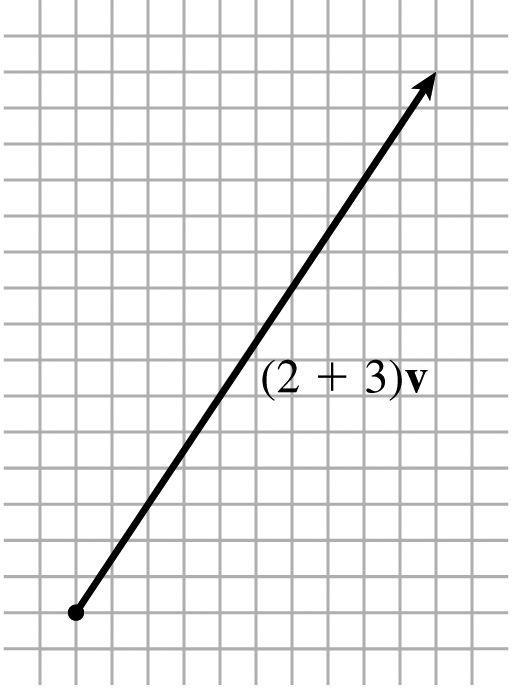
- (b)
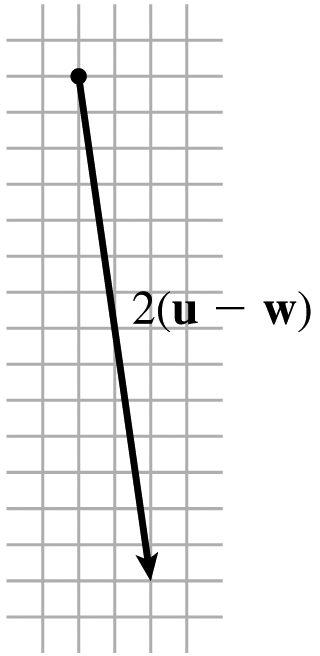
- (c)
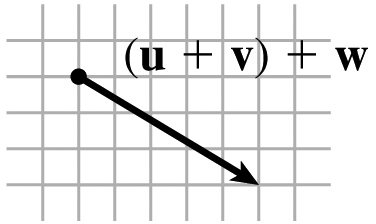
- (d)
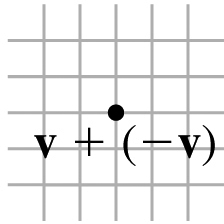
- (e)
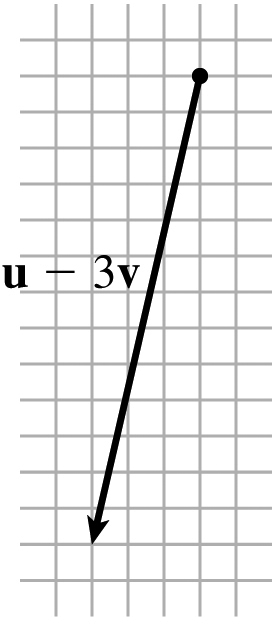
Determine whether the lines l_{1} and l_{2} intersect, are parallel, or are skew. \begin{array}[t]{ll} l_{1}\hbox{:}~ & ~\dfrac{x+5}{6}=\dfrac{y-2}{3}=\dfrac{z+4}{7} \\ l_{2}\hbox{:}~ & ~\dfrac{x+5}{6}=\dfrac{y+1}{3}=\dfrac{z-2}{7} \end{array}
Find the general equation of the plane containing the point ( 2, -1, 4) and normal to the line \dfrac{x+3}{2}=\dfrac{y-3}{3} =z.
2x+3y+z=5
Determine whether the lines l_{1} and l_{2} intersect, are parallel, or are skew. \begin{equation*} \begin{array}{ll} l_{1}\hbox{:}&x=t+1,\qquad y=3t,\qquad z=t-1 \\ l_{2}\hbox{:}&\dfrac{x+3}{2}=\dfrac{y-3}{3}=z \end{array} \end{equation*}
Find a line normal to the plane containing the lines \begin{equation*} x-2=\frac{y+1}{2}=\frac{z-1}{2}\qquad \hbox{and }\qquad x+1=\frac{y+8}{3}= \frac{z}{-3} \end{equation*}
at their point of intersection.

Find the line containing the points P_{1}=( 4,0,7) and P_{2}=( 5,3,6).
In Problems 33–37:
- (a) Identify each quadric surface.
- (b) List its intercepts and traces.
- (c)
 Graph the quadric surface.
Graph the quadric surface.
\dfrac{x^{2}}{4}-\dfrac{y^{2}}{9}=1
- (a) Hyperbolic cylinder
- (b) Intercepts: (2,0,0) and (-2,0,0); trace in the xy-plane is \dfrac{x^2}4-\dfrac{y^2}9=1; the traces in the xz-plane are x = −2 and x = 2.
- (c)
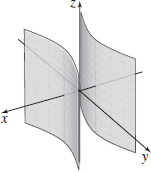
x^{2}+y^{2}-\dfrac{z^{2}}{4}=-1
z=\dfrac{x^{2}}{4}-\dfrac{y^{2}}{9}
- (a) Hyperbolic paraboloid.
- (b) Intercept: (0,0,0); traces: xy-plane, the pair of lines \dfrac{y}3=\pm \dfrac{x}2, which intersect at the origin. The trace in the xz-plane is the parabola z=\dfrac{1}{4}x^2, and the trace in the yz-plane is the parabola z=-\dfrac{1}{9}y^2.
z^{2}=\dfrac{x^{2}}{4}+\dfrac{y^{2}}{9}
\dfrac{x^{2}}{4}+\dfrac{y^{2}}{9}+z^{2}=1
- (a) Ellipsoid
- (b) Intercepts: (2,0,0), (-2,0,0), (0,3,0), (0,-3,0), (0,0,1), (0,0,-1); traces: xy-plane, \dfrac{x^2}4+\dfrac{y^2}9=1; yz-plane, \dfrac{y^2}9+z^2=1; xz-plane, \dfrac{x^2}4+z^2=1
- (c)
